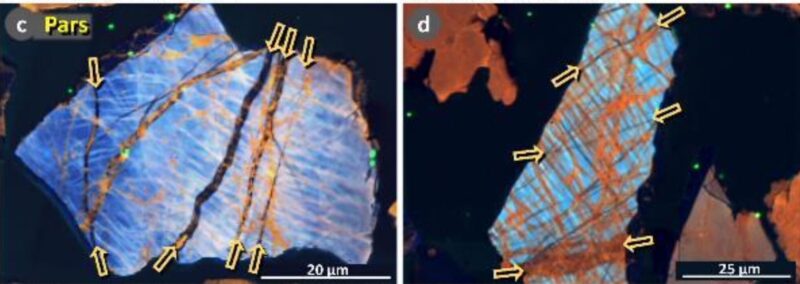Comet burst almost killed humanity 12,800 years ago
About 12,800 years ago – a geological blink of the eye – global temperatures suddenly and dramatically plummeted. The icy conditions of the Younger Dryas cooling period lasted more than 1,200 years. But it shouldn’t have happened. Earth was warming when the cooling began. On June 25, 2024, scientists said they’ve found more evidence that a comet impact might have been responsible for Earth’s sudden cooling.
The researchers published their peer-reviewed paper on May 8, 2024, in the ScienceOpen journal Airbursts and Cratering Impacts. They said physical evidence shows a 62-mile-wide (100-km-wide) comet exploded just about the same time humanity invented agriculture.
Previously published studies show human populations dropped dramatically at the same moment. The resulting bottleneck almost ended the human race. It took us more than three centuries to begin our recovery.

Exotic materials and microscopic metals litter Earth
Because the hypothetical comet never hit the ground, evidence for it comes from an abundance of tiny particles in the geological record. These micro-size bits of material – the metals iridium and platinum, exotic magnetic micro-spherules, melt glass and miniscule nanodiamonds – cover the entire globe. Scientists have found these particles in the layer of sediment that matches the start of the Younger Dryas.
Emeritus Professor James Kennett of the University of California, Santa Barbara’s earth science department said the team found strong evidence supporting a cometary airburst:
There’s a whole range of different shocked quartz, so we have to make a well-documented case that they are indeed significant for interpreting cosmic impact, even though they’re not reflecting a traditional major crater-forming event. These are from very-low-altitude “touchdown” airbursts almost certainly associated with cometary impact.
Kennett is one of several authors of the new paper. The latest publication is part of a series of scholarly works providing mounting evidence a cosmic impactor altered humanity’s destiny. Kennett’s research even hints the comet strike sparked widespread adoption of agriculture.

Comet burst came from a comet at least 60 miles wide
While there’s evidence of fallout from the comet’s atmospheric explosion all over the Earth – even in Australia – the latest paper focuses on three locations in the eastern United States. All were on the East Coast: Flamingo Bay, South Carolina; Parsons Island, Maryland; and Newtonville, New Jersey. A distance of 620 miles (1,000 km) separates the survey sites.
Of special interest to the researchers are lamellae, tiny laminated layers of alternating materials in the micro-size particles. Their abundance in the geologic record at 12,800 years ago provides strong evidence for a Younger Dryas comet impact. Kennett explained their importance:
In the extreme form, such as when an asteroid hammers into the Earth’s surface, all the fractures are very parallel. When you think about it, the pressures and temperatures that produce these fractures will vary depending on the density, entry angle, altitude of the impact and the impactor’s size.
With that in mind, the evidence suggests the Younger Dryas comet was about 62 miles (100 km) wide. That’s much larger than the object that killed the dinosaurs. The Chicxulub impactor – suspected of wiping out much of life on Earth – was likely an asteroid. The asteroid that took out the dinos was only 6 miles (10 km) across. Yet because it was so much more dense and actually hit Earth, it was far more destructive.
The Younger Dryas comet burst was more like the atmospheric explosion of a meteor over Tunguska in Russia in 1908. That object was likely just 130 feet (40 meters) wide. But, it took out 830 square miles (2,150 square km) of forest. It also left no impact crater.
The Younger Dryas impact hypothesis remains controversial. There have been repeated attempts to refute the conclusion. Yet the physical evidence in support of the idea continues to mount. In this video, the Prehistory Guys present the history of the evidence – and objections to it – that a comet strike coincided with the start of the Younger Dryas.Megafauna extinction and the lost Clovis Culture
The Younger Dryas comet didn’t come down in one piece. Researchers theorize it fragmented before it exploded. Multiple detonations are responsible for the worldwide distribution of the microscopic particles the disastrous collision left behind. It changed the world forever; the research team wrote:
The consequences of this event, including possible global effects on environmental ecosystems, glacial ice sheets, megafaunal extinctions and human populations, are yet to be fully understood but need to be evaluated in the context of a geologically instantaneous and likely catastrophic event.
The airburst might also be the event that sealed the fate of the North American Clovis culture. This toolmaking tradition’s practitioners crafted unique shapes for their weapons. Research by other scholars shows a 52% decline in Clovis spearpoints at the same time the suspected cosmic visitor arrived.
The world’s megafauna were already dying off about 40,000 years before the Younger Dryas set in. Yet there’s evidence in the fossil record the extinction process sped up at that time.
Still, not all scientists accept the Younger Dryas impact hypothesis as the cause of the cooling. Others believe the jet stream shifted, causing polar ice to melt. And there’s evidence the Atlantic meridional overturning circulation (AMOC) – which is currently at its weakest in 1,000 years – failed entirely.
The AMOC may again be on the verge of collapse.
Bottom line: New evidence suggests a celestial body exploded in Earth’s atmosphere 12,800 years ago. The catastrophic comet burst may have cooled Earth’s climate for around 1,200 years.
Via University of California, Santa Barbara
Read more: ECP contributor Yuri Beletsky’s best photos of Comet C/2014 Q1 (PANSTARRS)
Read more: Extinction of giant herbivores changed global landscapes











